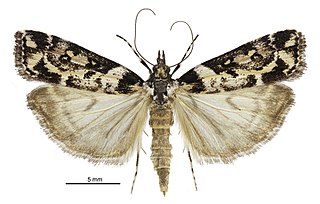
Hoplodrina blanda is a moth of the family Noctuidae. It is found in the Palearctic realm.

Mesapamea secalis, the common rustic, is a moth of the family Noctuidae. The species was first described by Carl Linnaeus in his 1758 10th edition of Systema Naturae. It is found in Europe, north-west Africa, Turkey and northern Iran.

Eulia ministrana is a moth of the family Tortricidae. It is found in the Palearctic and Nearctic realms.

Acleris holmiana, the golden leafroller moth, is a moth of the family Tortricidae. It is found in most of Europe and Asia Minor.

Eudonia diphtheralis is a species of moth in the family Crambidae. It is endemic to New Zealand.
Chersomorpha taospila is a species of moth of the family Tortricidae. It is found on New Ireland in Papua New Guinea.

Cnephasia longana, the omnivorous leaftier moth, long-winged shade or strawberry fruitworm, is a moth of the family Tortricidae. It was described by Adrian Hardy Haworth in 1811. It is native to western Europe. It is an introduced species in western North America. The species has also been reported from north-western Africa and Asia. The habitat consists of downland and rough ground.

Gelophaula lychnophanes is a species of moth of the family Tortricidae. It is found in New Zealand.
Gelophaula palliata is a species of moth of the family Tortricidae. It is found in New Zealand.
Gelophaula vana is a species of moth of the family Tortricidae. It is found in New Zealand.

Eucosma cana, the hoary bell, is a species of moth of the family Tortricidae.

Glaucocharis pyrsophanes is a moth in the family Crambidae. It was described by Edward Meyrick in 1882. It is endemic to New Zealand.

Protithona fugitivana is a species of moth of the family Tortricidae. It is endemic to New Zealand.

Pyrgotis eudorana is a species of moth of the family Tortricidae. It is endemic in New Zealand and has been observed in both the North and South Islands. However it is regarded as a rare insect. This species inhabits native forest. Larvae exclusively feed on Muehlenbeckia australis and adults are on the wing from November to April. Adults are attracted to light.
Ardozyga tabulata is a species of moth in the family Gelechiidae. It was described by Edward Meyrick in 1904. It is found in Australia, where it has been recorded from New South Wales and South Australia.
Antaeotricha subdulcis is a moth of the family Depressariidae. It is found in Brazil (Para) and Bolivia.
Epichostis tympanias is a moth in the family Xyloryctidae. It was described by Edward Meyrick in 1908. It is found in Assam, India.
Hypercallia argyropa is a moth in the family Depressariidae. It was described by Edward Meyrick in 1914. It is found in Peru.

Tingena horaea is a species of moth in the family Oecophoridae. It is endemic to New Zealand and have been observed in both the North and South Islands. The adults are on the wing in January.

Tingena idiogama is a species of moth in the family Oecophoridae. It is endemic to New Zealand and has been observed on the slopes of Mount Taranaki. Its preferred habitat is native subalpine scrub and adults are on the wing in January.













